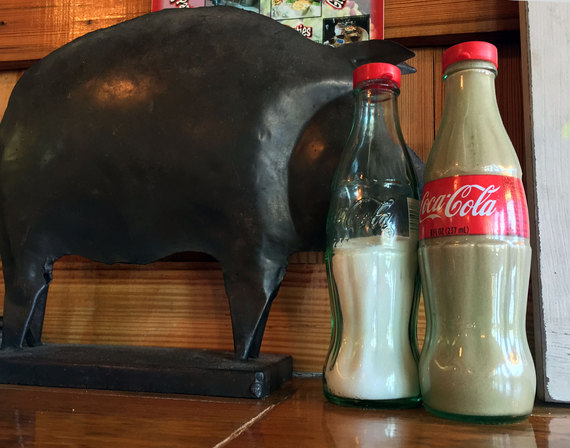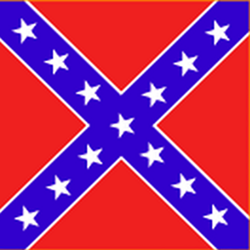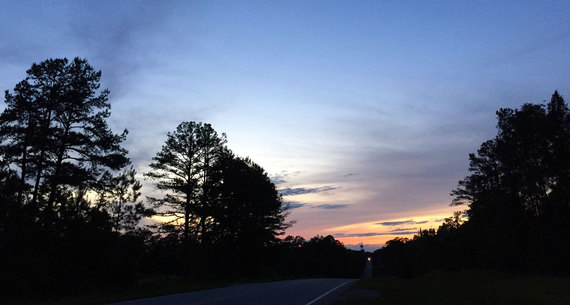Two months ago, I phoned my husband while driving through southwest Georgia's red clay fields and tree-lined hills.
"Remind me why I don't want to live here," I choked, eyes watered. "I mean, I know I don't want to live here, but the pull of the land..." I couldn't continue.
"Why, land is the only thing in the world worth workin' for, worth fightin' for, worth dyin' for, because it's the only thing that lasts."
~ Gerald O'Hara, Gone With The Wind, 1936
My mother instilled this message long before I read GWTW. And I read the book long before I saw the movie. That was, after all, long before VCRs and DVDs.
"The land" of my mother represented a rootedness that did not jibe with my desire to get away. I left for college with the (unarticulated) goal of never seeing a farm or farmer again ... yet I would get a master's degree in agricultural economics and then work for a northeastern dairy cooperative.
Nevertheless, I had flown the coop.
After moving to the Pacific Northwest, I swore I'd not return during the period from Memorial Day to Labor Day. (Those days of white shoes, burning sun and sweltering humidity.)
 Visits to southwest Georgia revolve around end-of-year holidays, family reunions and the occasional wedding/anniversary. They are marked by cultural touchstones: a Waffle House breakfast, boiled peanuts, fried catfish, sweet tea, camellias in bloom (if I'm lucky). Coca-Cola, with its high sugar load, is a treat of the past.
Visits to southwest Georgia revolve around end-of-year holidays, family reunions and the occasional wedding/anniversary. They are marked by cultural touchstones: a Waffle House breakfast, boiled peanuts, fried catfish, sweet tea, camellias in bloom (if I'm lucky). Coca-Cola, with its high sugar load, is a treat of the past.
As I have aged, each visit has become a little more painful due to the troubling words that wash over me from the mouths of relatives and neighbors and friends.
The changes on display in the South do not seem to be those of progression but rather of regression. For example, when I was in the eighth grade, we had a girl's-only sex ed class. I cannot image such a thing in today's political climate.
Today's South seems more evangelical, more enamored with a glorified past, less open to opposing views. People do not seem to hear the bigotry sprinkled throughout their speech. Perhaps that's not a surprise, since oral history was the only post-Civil War regional history that we were taught. Just as a fish is not aware of the water that surrounds it, we unconsciously absorb and integrate cultural messages. One of those messages was that the symbols of the Confederacy were to be venerated.
Not too long after I had become part of a community of motorcyclists who like good food and spirited debate, I got into an argument about the reasons for the Civil War. It was not slavery, I insisted, but northern industrialization that was subsidized by tax dollars.
I was wrong.
I didn't know that Alexander Stevens, Confederate States of America vice president and 50th Georgia governor said this, to applause:
Our new government is founded upon ... the great truth, that the negro is not equal to the white man; that slavery -- subordination to the superior race -- is his natural and normal condition.
Nor had I learned in school that the Confederate flag bandied about today is a 20th century fabrication, as well as the chosen symbol of the KKK [1]. Come to think, that ugly symbol of hate seems far more routinely displayed today than when I was growing up in the 60s and 70s.
"Those who cannot remember the past are condemned to repeat it."
~ The Life of Reason, Santayana, 1905
Perhaps this lack of contextual history can explain South Carolina Governor Nikki Haley's flip-flops on the Confederate flag flying at the capitol.
The first generation American daughter of Indian immigrants was born and reared in South Carolina. Somehow - I'm not sure how - she thinks that her election "fixed" the historical racism that South Carolinians have exhibited towards black Americans.
Moreover, in an election debate last fall, she quipped:
What I can tell you is over the last 3½ years, I spent a lot of my days on the phones with CEOs and recruiting jobs to this state. I can honestly say I have not had one conversation with a single CEO about the Confederate flag.
It seems impossible that she could speak those words if she knew of the political hay that has been made with the Confederate flag. Dixiecrats nominated South Carolina Governor Strom Thurmond as a candidate for the presidency after the 1948 national Democratic convention, where the Confederate Battle Flag waved boldly. Afterwards, "[s]ales of Confederate flags, long moribund, exploded."
It was not until 1961, on the 100th anniversary of South Carolina triggering the Civil War when it attacked Fort Sumter, that the Confederate flag would begin flying above the S.C. state Capitol.
In-between those two events: Brown v The Board of Education.
 This very flag, the Battle Flag, flew over "an army raised to kill in defense of slavery." It was "revived by a movement that killed in defense of segregation." And last week, a modern version was "flaunted by a man who killed nine innocents in defense of white supremacy," Yoni Appelbaum wrote in The Atlantic.
This very flag, the Battle Flag, flew over "an army raised to kill in defense of slavery." It was "revived by a movement that killed in defense of segregation." And last week, a modern version was "flaunted by a man who killed nine innocents in defense of white supremacy," Yoni Appelbaum wrote in The Atlantic.
On Monday, bowing to national outrage, Governor Haley told the S.C. legislature that she wants the flag to come down. That will require a two-thirds vote. Note that demands like this one do not have a great track record when it comes to future political livelihood.
But come down it must.
And all vestiges of the Confederacy must be excised from my home state flag as well.
The Confederate Battle Flag became a central part of Georgia's state flag in 1956. And what was happening then? Outrage at the Brown decision and desegregation.
I suddenly have a better understanding of why this historical information is as foreign to me as Mars: my education was hobbled by current events.
In 2003, Georgia's citizens approved a new flag design that substituted the original and lesser known flag of the Confederacy, the Stars and Bars, for the Battle Flag. Although it does not carry the emotional punch of the Battle Flag, it remains a conscious tentacle to a past marred by slavery.
Can you imagine a German municipality deciding to create a new flag that incorporated a swastika as its centerpiece? Me, either. So why do we whitewash our own tributes to hate? And willfully fail to acknowledge them?
***
I'm left wondering about my heartstrings.
Yes, April was an emotional period: my dad was in the hospital after having a mild stroke and carotid artery surgery. But that alone cannot explain my sudden and irrational exploration of ways I might find gainful employment in a rural corner of Georgia.
But it will always be home, warts and all. And warts? They're caused by a virus. The virus is more likely to cause a wart when it contacts skin that has been cut or otherwise damaged.
"Every wart is a mother wart that can have babies. You need to get rid of all visible warts whenever they appear so you don't have more spread," dermatologist Robert Brodell, MD, told WebMD.
The Confederate flag is like a virus. Bigotry is the wart that it creates when minds are susceptible to its connotation. Removing that symbol -- with very public dialog about why it needs to be removed -- is one step towards excising the larger, persistent social ill that is racism.
"It is place, permanent position in both the social and topographical sense, that gives us our identity."
~ J.B. Jackson
Photos by Kathy Gill; Battle Flag, NPS.
[1] The St. Andrews Cross became a Confederate Army Battle Flag; the it was always square. A horizontal version of this flag appeared mid-20th century. In addition, the dark blue of today's pop culture Confederate flag is borrowed from the Stars and Bars.

